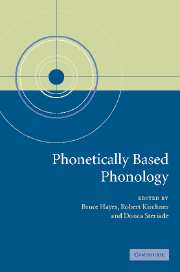Book contents
- Frontmatter
- Contents
- List of contributors
- List of abbreviations
- 1 Introduction: the phonetic bases of phonological Markedness
- 2 A review of perceptual cues and cue robustness
- 3 Place assimilation
- 4 The typology of rounding harmony
- 5 The evolution of metathesis
- 6 The role of contrast-specific and language-specific phonetics in contour tone distribution
- 7 Vowel reduction
- 8 Contrast and perceptual distinctiveness
- 9 Syllable weight
- 10 Consonant lenition
- 11 Language processing and segmental OCP effects
- Index
6 - The role of contrast-specific and language-specific phonetics in contour tone distribution
Published online by Cambridge University Press: 21 October 2009
- Frontmatter
- Contents
- List of contributors
- List of abbreviations
- 1 Introduction: the phonetic bases of phonological Markedness
- 2 A review of perceptual cues and cue robustness
- 3 Place assimilation
- 4 The typology of rounding harmony
- 5 The evolution of metathesis
- 6 The role of contrast-specific and language-specific phonetics in contour tone distribution
- 7 Vowel reduction
- 8 Contrast and perceptual distinctiveness
- 9 Syllable weight
- 10 Consonant lenition
- 11 Language processing and segmental OCP effects
- Index
Summary
Introduction
In some tone languages, contour tones (pitch changes within a syllable) may be used contrastively. The phonological distribution of contour tones has been of much theoretical interest, as it sheds light on both the representation of tone (Woo 1969; Leben 1973; Goldsmith 1976; Bao 1990; Duanmu 1990, 1994a; Yip 1989, 1995) and the relation between phonetics and phonology (Duanmu 1994b; Gordon 1998; Zhang 1998, 2002a).
Contour tones are commonly restricted to phonemic long vowels, as inNavajo (Young and Morgan 1987), or to stressed syllables, as in Xhosa (Lanham 1958). I ask the following questions in this chapter: What is the link between these two contexts? Should they be accounted for by independent mechanisms, based on contrastive vowel length and stress respectively, or by some unified mechanism? Drawing from typological and instrumental data, I argue that the unifying factor for contour tone licensing is sonorous rhyme duration, and that the distribution of contour tones is determined by phonetic categories for duration and sonority rather than abstract structural categories based on contrastive vowel length or stress.
The argument goes as follows. The articulation and perception of contour tones determine that they need a sufficient sonorous rhyme duration to be implemented. Thus, a long sonorous rhyme duration is the unifying factor for privileged contour tone licensers. Examining contour tone distribution crosslinguistically, we find that (a) the types of syllables on which contour tones are more likely to occur are exactly those that independently have a longer duration and higher sonority in the rhyme; and (b) the privileged contour tone licensers include not only long-vowelled and stressed syllables, but also syllables in other contexts shown in the literature to undergo lengthening, namely phrase-final position and shorter words.
- Type
- Chapter
- Information
- Phonetically Based Phonology , pp. 157 - 190Publisher: Cambridge University PressPrint publication year: 2004
- 23
- Cited by

